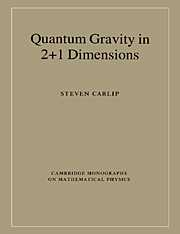Book contents
- Frontmatter
- Contents
- Preface
- 1 Why (2+1)-dimensional gravity?
- 2 Classical general relativity in 2+1 dimensions
- 3 A field guide to the (2+1)-dimensional spacetimes
- 4 Geometric structures and Chern–Simons theory
- 5 Canonical quantization in reduced phase space
- 6 The connection representation
- 7 Operator algebras and loops
- 8 The Wheeler–DeWitt equation
- 9 Lorentzian path integrals
- 10 Euclidean path integrals and quantum cosmology
- 11 Lattice methods
- 12 The (2+1)-dimensional black hole
- 13 Next steps
- Appendix A The topology of manifolds
- Appendix B Lorentzian metrics and causal structure
- Appendix C Differential geometry and fiber bundles
- References
- Index
12 - The (2+1)-dimensional black hole
Published online by Cambridge University Press: 15 December 2009
- Frontmatter
- Contents
- Preface
- 1 Why (2+1)-dimensional gravity?
- 2 Classical general relativity in 2+1 dimensions
- 3 A field guide to the (2+1)-dimensional spacetimes
- 4 Geometric structures and Chern–Simons theory
- 5 Canonical quantization in reduced phase space
- 6 The connection representation
- 7 Operator algebras and loops
- 8 The Wheeler–DeWitt equation
- 9 Lorentzian path integrals
- 10 Euclidean path integrals and quantum cosmology
- 11 Lattice methods
- 12 The (2+1)-dimensional black hole
- 13 Next steps
- Appendix A The topology of manifolds
- Appendix B Lorentzian metrics and causal structure
- Appendix C Differential geometry and fiber bundles
- References
- Index
Summary
The focus of the past few chapters has been on three-dimensional quantum cosmology, the quantum mechanics of spatially closed (2+1)-dimensional universes. Such cosmologies, although certainly physically unrealistic, have served us well as models with which to explore some of the ramifications of quantum gravity. But there is another (2+1)-dimensional setting that is equally useful for trying out ideas about quantum gravity: the (2+1)-dimensional black hole of Bañados, Teitelboim, and Zanelli introduced in chapter 2. As we saw in that chapter, the BTZ black hole is remarkably similar in its qualitative features to the realistic Schwarzschild and Kerr black holes: it contains genuine inner and outer horizons, is characterized uniquely by an ADM-like mass and angular momentum, and has a Penrose diagram (figure 3.2) very similar to that of a Kerr–anti-de Sitter black hole in 3+1 dimensions.
In the few years since the discovery of this metric, a great deal has been learned about its properties. We now have a number of exact solutions describing black hole formation from the collapse of matter or radiation, and we know that this collapse exhibits some of the critical behavior previously discovered numerically in 3+1 dimensions. We understand a good deal about the interiors of rotating BTZ black holes, which exhibit the phenomenon of ‘mass inflation’ known from 3+1 dimensions. Black holes in 2+1 dimensions can carry electric or magnetic charge, and can be found in theories of dilaton gravity. Exact multi-black hole solutions have also been discovered.
In this chapter, we shall concentrate on the quantum mechanical and thermodynamic properties of the BTZ black hole.
- Type
- Chapter
- Information
- Quantum Gravity in 2+1 Dimensions , pp. 194 - 211Publisher: Cambridge University PressPrint publication year: 1998

